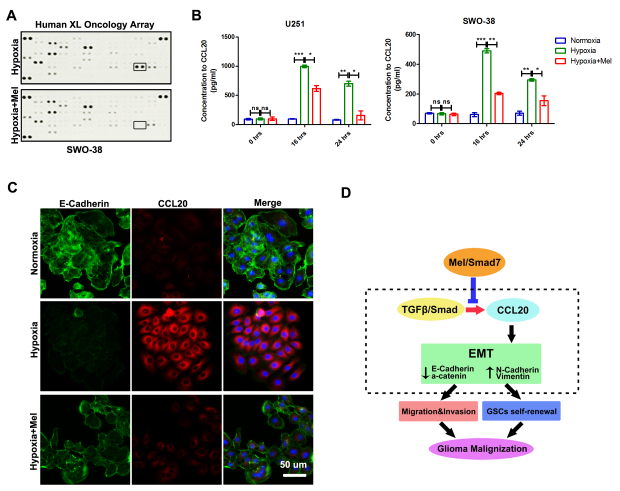
Glioma is the most common and lethal type of primary brain tumor. Tumor cells infiltrate into and invade the surrounding normal brain tissues, largely accounting for malignant progression and recurrence of gliomas, especially in glioblastoma multiforme.
Therefore, it is essential to investigate the molecular mechanisms driving glioma aggressive behavior for the development of a curative therapy for glioma patients.
To aim at this, a study team led by Prof. FANG Zhiyou and Dr. CHEN Xueran in the Center of Medical Physics and Technology (CMPT), Hefei Institutes of Physical Science of the Chinese Academy of Sciences, revealed a novel interaction between glioma malignant transformation and tumor micro-environment. Their work was published online in Oncotarget.
The tumor microenvironment is the cellular environment in which the tumor exists, including tumor cells, immune cells, lymphocytes, signaling molecules and the extracellular matrix.
Notably, few chemokines derived from tumor-associated leukocytes or tumor cells act as growth factors for cancer cells, and could contribute to tumor metastasis by accelerating angiogenesis, attracting endothelial cells or regulating the motility of cancer cells.
Among these, CCL20 has been proven to be related to invasion and metastasis in some types of cancer.
Moreover, Melatonin (N-acetyl-5-methoxytryptamine), a hormone that is naturally produced and secreted by the pineal gland, has been proven to be effective in tumor inhibition, in both in vitro and in vivo studies. So that it inhibits cell viability and proliferation, and induces apoptosis, in breast cancer cells and glioma cells.
Prof. FANG Zhiyou, Dr. CHEN Xueran and their coworkers analyzed the roles of the tumor microenvironmen factors, melatonin and CCL20 in glioma cell lines, and glioma mice. They also examined the significance of this interaction with respect to the malignant progression of gliomas.
Through the study, they found that melatonin could significantly suppress the release of the cytokine, CCL20, from cancer cells and antagonize glioma cell metastasis and invasion under hypoxic stress in glioma cells.
Furthermore, their findings show that melatonin deregulates Smad7 expression to suppress TGFβ/Smad-mediated increase in CCL20 transcript levels and CCL20-induced tumor recurrence.
Taken together, these work indicated that melatonin may be used as a novel therapeutic to treat malignant transformation in gliomas.
This work was supported by grants from the National Natural Science Foundation of China and Anhui Provincial Nature Science Foundation.

Figure. The role of melatonin in CCL20-mediated glioma malignant progression. (A-C) The change in the cytokine profile associated with melatonin-mediated malignant progression of glioma cells in hypoxia was detected by The Human XL Oncology Array. CCL20, indicated by a square frame. (B) The secretion level of CCL20 was determined by ELSA in U251 and SWO-38 cellstreated with or without melatonin under hypoxia. (D) schematic diagram showing the roles of melatonin on recurrence and metastasis in glioma cells. Melatonin unregulated Smad7 expression to suppress TGFβ/Smad-mediated CCL20 transcript level and CCL20-induced glioma reccurrence, suggesting potential therapeutic strategy of melatonin to overcome malignant transformation in gliomas. (Image by CHEN Xueran)

86-10-68597521 (day)
86-10-68597289 (night)

86-10-68511095 (day)
86-10-68512458 (night)

cas_en@cas.cn

52 Sanlihe Rd., Xicheng District,
Beijing, China (100864)

